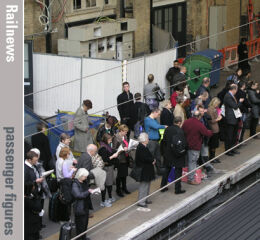Posted 25th November 2021 | 1 Comment
New figures reveal effect of lockdowns on rail travel

NEW figures from the Office of Rail and Road reveal that passenger travel by train dropped by 78 per cent during 2020-21. This was the first full year of lockdowns caused by Covid-19, when travel by train was officially discouraged for months at a time.
The ORR has published its estimates of station usage during the year, and these show that the busier stations in London included major hubs in the suburbs for the first time. Britain's busiest station was Stratford in east London, with 13,985,162 entries and exits. Stratford displaced Waterloo, which had occupied the top spot for 17 years, but in 2020-21 entries and exits at Waterloo fell from 86.9 million the previous year to 12.2 million. London Victoria and London Bridge were both slightly ahead, with 13.8 million entries and exits.
However, other suburban interchanges have also entered the top ten. Highbury & Islington had 8.7 million and Clapham Junction 8.4 million, while both Barking and East Croydon had 6.7 million users.
The only station outside London with more than 6 million entries and exits was Birmingham New Street, with 7.4 million. Glasgow Central had 5.3 million users, compared with 32.5 million the previous year. Cardiff Central also remained the busiest station in Wales during 2020-21 but had just under 2 million entries and exits compared to more than 12 million in 2019-2020.
Only five railway stations in Britain had more than 10 million entries and exits in 2020-21, compared with 43 stations in 2019-20, while nearly 200 stations had fewer than 1,000 entries and exits.
Last year’s least used station was Berney Arms in Norfolk, with 42 entries and exits. In 2020-21, the number of entries and exits at this station increased to 348. The ORR acknowledged that publishing the details of the least used stations can result in more people being attracted to them.
The station usage figures are only estimates, and are based on ticket sales. The ORR warned: 'Some ticket sales and ticketless travel are not included, which may mean that usage at some stations is underestimated. It should be noted that levels of ticketless travel may have changed during the pandemic and those changes may vary substantially by station.'
ORR director of planning and performance Feras Alshaker said: 'Throughout 2020-21 the railways remained an essential service for those people who needed to travel during a year which was impacted by the pandemic.
'We’ve seen a radical change, especially in London, in the stations people were using the most. Stratford, Highbury and Islington, Clapham Junction, Barking and East Croydon replaced Kings Cross, St. Pancras, Euston and Paddington in the top ten, underlining their importance as vital stops and interchanges, linking key workers with underground and bus services to travel.
'This year we have seen many railway stations with very few passenger entries and exits. However, we know that recent figures show leisure journeys are nearly back to pre-pandemic levels, while there has been a slower increase in commuter journeys.'
Rail Delivery Group director general Andy Bagnall said: 'The station usage figures show how the rail industry kept people moving for the first year of the pandemic. Some of the entries on the list reflect where people like key workers were travelling from and also the acceleration of changes to how people are travelling after the pandemic.
'Rail companies are working together to welcome people back and the recent increase in passengers continues to both reflect and support the nation’s recovery.'
Reader Comments:
Views expressed in submitted comments are that of the author, and not necessarily shared by Railnews.

Robert Palmer, Norwich
Wasn't the low usage of Berney Arms in 2020/21 due in part to the line running past it being closed for several months during the resignalling of the Wherry lines?
[It was. The bird enthusiasts couldn't get there!--Ed.]